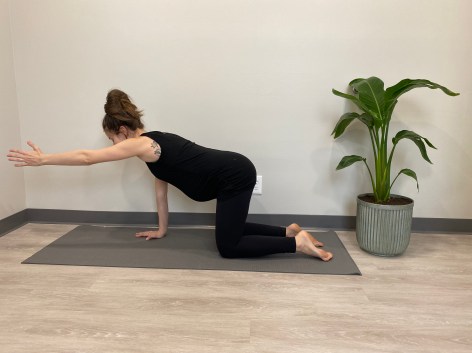Yesterday afternoon, I met my team of pelvic PTs at at the office for some photo and video time. Our model? Dr. Kellie, who is about to have her last week with us in the clinic before leaving on maternity leave for her second daughter. You see, working at a pelvic PT practice, we have to take advantage of one of our own being pregnant! How could we miss an opportunity to record videos and take pictures to expand our library! 🙂
Movement during pregnancy is incredibly useful. First, it can help with many of the aches and pains that commonly develop. It helps to keep your muscles active, and ultimately, can help prepare you for the process of labor and birth. We wrote a while back on healthy exercise during pregnancy, so start there if you want to know where you should get started for movement.
Today, I wanted to focus on movement to help you feel better. These exercises promote gentle movement around your spine and pelvis and activation of the muscles around your deep core.
Cat-Cow
Goal: Improve mobility around your spine and pelvis. Coordinate movement with breathing.
- Inhale slowly, and as you do, gently let your tailbone out, and lift your head
Try not to allow your back to dip super far down but stay within a comfortable range.
2. Exhale and gently tuck your head, lifting your belly up and rounding your spine, allowing your tailbone to tuck.
3. Repeat this flowing gently with your breath as you inhale and exhale
Aim to do this 10-15 times in a row, alternating with the modified child’s pose that is described below.
Modified Child’s Pose
Goal: Lengthen lower back, gluteal muscles, pelvic floor, and inner thighs. Encourages relaxation and opening around the pelvis.
This exercise works really nice to alternate between sets of the Cat-Cow.
- First, place pillows in front of you, leaving a gap for your belly. You can use 1-3 pillows, depending on your belly size.
- Sit back on your heels, and open your knees to a comfortable width.
- Lean over the pillow, allowing your body to relax and reaching your arms forward. Let your head rest to one side or the other.
- Relax in this position for 1-2 minutes.
Ball Pelvic Mobility
Goal: Improve the movement around your pelvis and spine
- Sit comfortably on an exercise ball with your feet supported on the floor
- Inhale, letting your pelvis out, allowing a small arch in your back
- Exhale, tucking your pelvis under gently pulling your belly in.
- Repeat this to warm-up x 10
- Then, add a rotation, inhaling and rotating clockwise with your pelvis until you reach the arched back position. Then exhale, continuing to rotate clockwise until you reach the tucked position.
- Repeat this x 5-10 repetitions, then switch to counter-clockwise.
Bird-Dog Progression

Goal: Activate your deep abdominals and pelvic floor muscles paired with your breath.
- Begin in a hands and knees position with your spine in a neutral position (not flexed or arched)
- Inhale to prepare, exhale and gently engage your pelvic floor muscles while gently drawing in your belly. Aim for a slight contraction (not hard!).
- While you do this, extend one arm in front of you.
- Exhale, lowering your arm and relaxing your muscles.
- Repeat, alternating lifting with your opposite arm. Be sure to keep your spine in a comfortable position while you are doing this exercise. Repeat this movement for 10-15 repetitions.
- To progress this exercise, you can also perform with an alternating leg movement, aiming to keep your spine in a neutral position.
Wall Squats
Goal: Coordinate movement with breath, activate pelvic floor with gluteal muscles
- Place a ball behind your back and lean against a wall. Keep your feet placed out in front of you, flat on the floor.
- Inhale while you bend your knees and lower.
- Exhale, engage your pelvic floor muscles slightly, and lift up to standing.
- Repeat this exercise for 10-15 repetitions, performing 2-3 sets.
Note: While doing this, keep your feet far enough in front of you that your knees don’t cross your feet.
I hope you’ve enjoyed these exercises! What exercises do you like to do to move well during pregnancy? Any favorites we need to add?
Look for more coming from us on all of this in the future!















